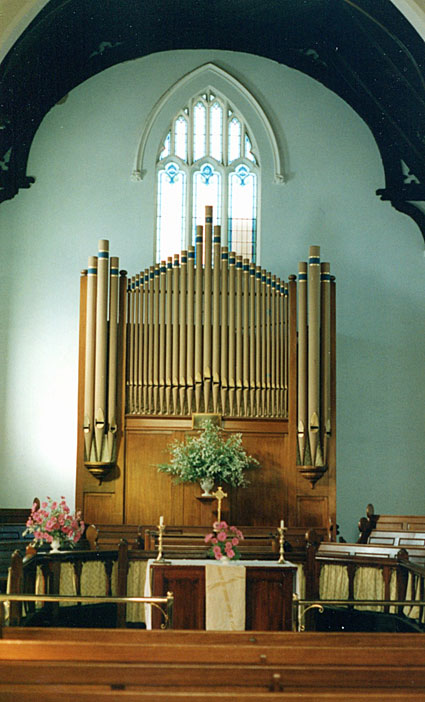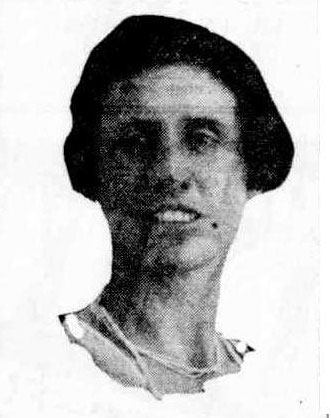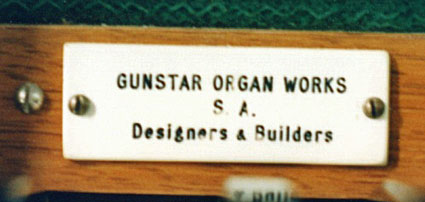
The Gunstar Organ Works instrument at the Uniting Church, Westbourne Park
[Photograph by David Shield (July 1996)]

The Gunstar Organ Works instrument at the Uniting Church, Westbourne Park
[Photograph by David Shield (July 1996)]
Historical and Technical Documentation by Bruce Naylor and David Shield
© OHTA 1971, 1999, 2019 (last updated October 2019)
The organ in this location was built by Gunstar Organ Works, Plympton, for the Methodist (later Uniting) Church, Westbourne Park. The church was closed for renovations over six months before being reopened at a dedicatory service on Saturday 11 March 1939. A new chancel, vestries, and porches had been added and the new pipe organ had been installed.1 The organ was opened by Mrs A.H. Morphett, who had 'conducted the choir so splendidly for nearly twenty years.'2

Mrs A.H. Morphett, Organist, Methodist Church, Westbourne Park
[Photograph from News (10 April 1930), p. 8.]
The first recital on the newly installed instrument was given on Saturday 22 April 1939 by Harold S. Parsons:
Organ Recital At Westbourne Park Church
With Mr. Harold S. Parsons as guest organist, the first recital with the newly installed organ at the Westbourne Park Methodist Church was given on Saturday night in the presence of more than 300 persons. The compositions which Mr. Parsons chose for the organ included the Concerto in B Flat (Handel), the Sonata in C Minor (Mendelssohn), three Choral Preludes of Johann Sebastian Bach, the Prelude to La Damoiselle Elue (Debussy), the Alpine Sketches of Cyril Scott, and Boellmann's Gothic Minuet. In addition Miss Joan Kneebone (violin) contributed the Air on a G String, of Bach, and the Romance of Wieniawski, and the choir of the church, with Mrs A. H. Morphett conducting, sang the anthems 'Hear My Prayer' (Mendelssohn); and 'The Lord 's Prayer' (Malotte). The organ was built at Plympton by the Gunstar Organ Works, at a cost of about £600. lt was installed about four weeks ago. It is equipped with an electric unit, 16 speaking stops, and six couplers.3
Built during a time of austerity, the organ apparently used soundboards from an older Wurlitzer organ. Longer lengths of zinc for the large display pipes were scarce so a special technique was devised to construct the pipes from shorter lengths. The colour scheme for the pipes devolved from the colour of a biscuit favoured at the time and allowing a blend with the décor of the church.4 With a detached console and electric action it was located centrally behind the altar table with choir stalls either side.
The original specification was not listed in the media reports. It would appear to have had 16 speaking stops and six couplers. Assuming that no additions were made in 1954, this would agree with a later photograph of the keyboard:

Console of the organ at Westbourne Park
[Photograph by David Shield (July 1996)]

Original nameplate on organ: Gunstar Organ Works SA Designers and Builders.
[Photograph by David Shield (July 1996)]
A memorial plaque, dated 17 August 1952, records that the organ was dedicated at this time to the memory of Hilda Rose Morphett (Mrs A.H. Morphett), who had died in the previous December.5 The occasion was the date of the Church Anniversary.6

Memorial Plaque to Hilda Rose Morphett
[Photograph by David Shield (July 2018)]
This organ was dedicated to the memory of Hilda Rose Morphett (nee Wheeler) on 17th August 1952 as a tribute to her life and faithful service as choir mistress and organist for 36 years (1916-1951). Called to higher service December 1951.
The organ was rebuilt in 1954 by J.E. Dodd & Sons Gunstar Organ Works. An oboe and sub and super octave couplers were added, and the specification was recorded as follows:
1 2 3 4 5 6 7 8 9 10 11 12 13 14 15 16 17 |
GREAT ORGAN Open diapason Clarabel Stopped diapason Octave diapason Stopped flute Nazard Mixture (26.29) Swell to Great Swell to Great sub Swell to Great super Great Sub Great Super SWELL ORGAN Bourdon Stopped diapason Principal Stopped flute Principal Oboe tremulant Swell Sub Swell Super Unison off PEDAL ORGAN Bourdon Echo Bourdon Bass flute Principal Swell to Pedal Great to Pedal |
8 8 8 4 4 2-2/3 II 16 8 4 4 2 8 16 16 8 4 |
(7 stops) (from No. 1) (from No. 3) (from No. 2) (from old viol) (6 stops) (from No. 3) (from No. 3) (from old viol) (from No. 3) (from old viol) [added 1954] (4 stops) (from No. 3) (from No. 3) (lower pressure) (from No. 3) (from old viol) |
Wood and metal pipes
Electro-pneumatic action
[Compass 61/30]
Unit chests
4 thumb pistons to great
3 thumb pistons to swell
balanced swell pedal
detached console
free standing behind pulpit
good acoustics.7
As early as May 1966, Tom Way, then organist of the church, recommended that the organ be replaced by a new mechanical-action instrument. In 1967-68, he changed the composition of the mixtures and mutations.8
The organ was advertised for sale early in 1992.9 Purchased privately in November 1994, it remained at Westbourne Park until the new organ took its place in 1996.
___________________
1 The Mail (11 March 1939), p. 8; News (11 March 1939), p. 2.
2 Australian Christian Commonwealth (31 March 1939), p. 12.
3 The Advertiser (24 April 1939), p. 23.
4 Personal communication from Gordon Gunn to David Shield, mid 1980s.
5 Mrs A H Morphett, nee Hilda Rose Wheeler, studied music under Miss Easom, of North Adelaide, and singing under Mr. Frederick Bevan, of Elder Conservatorium. She married Archie Harold Morphett in 1915. She was a prominent soprano with the Adelaide Philharmonic Society. For many years she was soloist in connection with Prospect Methodist Church under the direction of Harold Parsons, Mus.Bac. Under her leadership the Westbourne Park choir won many competitions, one of the most meritorious being the Centennial Choral Competitions of 1936. Mrs Morphett's other life long passion was women's bowls. She died in December 1951. [News (20 December 1928), p. 14; Obituary in The Advertiser (21 December 1951), p. 11.]
6 The Advertiser (16 August 1952), p. 19.
7 Specification noted by Bruce Naylor, 1969; [Pamphlet] Westbourne Park Methodist Church, 'Reopening of Memorial Pipe Organ, 4 March [1954]', cited in Bruce Allan Naylor, Organ Building in South Australia (MMus thesis, University of Adelaide, 1971), vol. 2, p. 749.
8 B.A. Naylor, Gazetteer of South Australian Pipe Organs (Melbourne: Society of Organists (Vic) Incorporated, 1974).
9 Organ Music Society of South Australia Inc. Newsletter (Dec. 91 / Jan. 92), vol. 24, no. 6 (Dec. 91 / Jan. 92), p. 5.